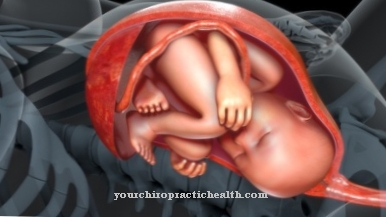The Conduction is a type of heat transport and one of four mechanisms with which the body exchanges heat with the environment within the framework of thermoregulation. The conduction is based on Brownian movements. They allow warmth in the insulated body to migrate from areas with higher temperatures to areas with lower temperatures.
What is the conduction?

According to the law of conservation of energy, energy is a conservation quantity. As a result, the total energy of an isolated system does not change, but at most transforms into different forms of energy. The law of conservation of energy also applies to heat transport in the isolated system of the human body.
The heat conduction in the human organism is also known as conduction and corresponds to the heat flow in a solid that takes place within the scope of temperature differences. According to the second law of thermodynamics, heat always flows in the direction of the lower temperature. Unlike convection, conduction does not require any material flow for thermal transport. Heat transport takes place within the framework of conduction, i.e. without material transport via tissue. Skin contact with a material also creates heat conduction.
The amount of heat transported during conduction depends on the thermal conductivities and the temperature differences. The conduction is also called Heat diffusion and is one of four heat transfer mechanisms in the human body.
Function & task
The four physical mechanisms for heat transport in the human body are radiation, convection, evaporation and conduction.
Evaporation is a loss of heat through sweating as part of thermoregulation. Radiation refers to the infrared part of the thermal radiation and is therefore not bound to matter. Conduction means the heat transport in a resting body and convection is the heat transport by means of a moving medium.
Biology differentiates between an internal and an external heat transport. The external heat exchange is the permanent heat exchange that takes place through the skin with the environment. The internal heat transport means the transport of body heat starting at the place of heat source up to the body surface. Convection and conduction play a role in the internal heat flow.
In the case of conduction, heat is transported via the Brownian molecular motion of a substance. The jerky, irregular thermal movements of particles in a viscous medium are known as Brownian movement. The square of the distance covered increases on average in proportion to the absolute temperature and the time span. It is inversely proportional to the particle radius and viscosity. This principle underlies every biological diffusion.
When the heat is transferred through Brownian molecular movement, the heat gradient is compensated because the particles move in the direction of the lower temperature areas. The physical properties of the material determine the size of the resulting heat flow. In physiological tissues, the water balance is the leading factor. The thermal conductivity is determined by the coefficient of thermal conductivity. Like all other heat exchange mechanisms, conduction causes permanent heat loss and, at the same time, passive heating.
The human organism is dependent on a constant body temperature for all metabolic processes to function perfectly. The temperature is kept constant through constant heat production in the sense of thermogenesis, as well as through isolation from the environment and the ability to lower body temperature.
The body heat results from the energy conversion in two systems. The muscles and the metabolism are involved. The muscles turn chemical energy into kinetic energy. The heat transport of these energies takes place mainly through forced convection via the blood.
You can find your medication here
➔ Medicines for cold feet and handsIllnesses & ailments
Disturbed thermoregulation can cause numerous organ dysfunction in the human body and thus be a systemic disease. Since conduction is one of several causes of heat loss, it may be related to hypothermia. Hypothermia is hypothermia that occurs after exposure to the cold. The heat production in the body is less than the release of heat over a certain period of time. In extreme cases, hypothermia can be fatal.
Local exposure to cold causes frostbite, which permanently damages the tissue. Hypothermia plays a role, for example, in connection with mountain athletes who have had an accident and is automatically considered in intensive care units with the appropriate medical history and a suitable clinical picture.
Medicine distinguishes between different stages of hypothermia. Mild hypothermia is present at a body temperature between 32 and 35 degrees Celsius. Muscle tremors, tachycardias, tachypneas and vasoconstrictions or apathy and ataxia can usually be observed at these temperatures.
In moderate hypothermia, the temperature has dropped to 28 degrees Celsius. In addition to impaired consciousness, bradycardia and dilated pupils, the patient has a reduced gag reflex, hyporeflexia or cold idiocy.
Severe hypothermia is referred to at temperatures below 28 degrees Celsius, which, in addition to unconsciousness, can cause cardiac arrest, reduced brain activity, rigid pupils and cardiac arrhythmias or respiratory arrest.
Hypothermia can occur after accidents at water, in the mountains and in caves, or after staying in a considerably cold environment. Various diseases, sedentary behavior due to neurological defects, extreme physical exertion or states of shock can also trigger hypothermia. The same applies to excessive alcohol consumption and the associated dilation of blood vessels in the skin.
Patients with the rare Shapiro syndrome also suffer from fundamental and recurring defects in thermoregulation. As a thermoregulatory center, your hypothalamus is affected by disorders.



.jpg)




















.jpg)



